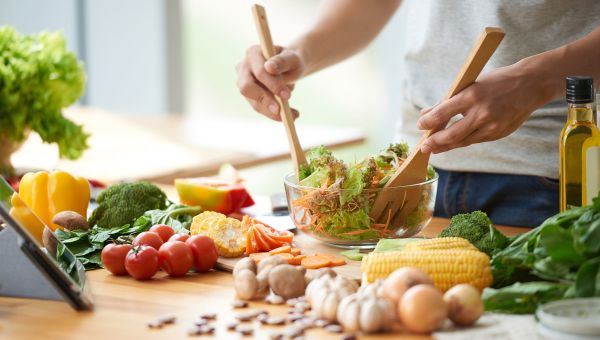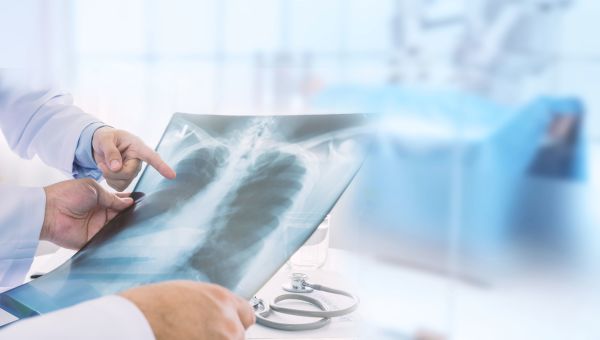6 ways to lower your risk of lung cancer
In addition to quitting tobacco, here are other things you can do to reduce your risk of this common cancer.
Updated on April 3, 2024

Lung cancer is the second most common cancer among men and women in the United States. It’s also the leading cause of cancer-related deaths, by far. More than 127,000 people in the U.S. are predicted to die of lung cancer in 2023 alone, according to the American Cancer Society.
While certain factors, like your genes, are uncontrollable, there’s actually quite a lot you… Show More
Lung cancer is the second most common cancer among men and women in the United States. It’s also the leading cause of cancer-related deaths, by far. More than 127,000 people in the U.S. are predicted to die of lung cancer in 2023 alone, according to the American Cancer Society.
While certain factors, like your genes, are uncontrollable, there’s actually quite a lot you may be able to do that can lower your risk of lung cancer.
Show Less
Quit smoking
Quitting smoking is the most essential step toward lung cancer prevention. That’s because smoking is the main cause of lung cancer. The habit is linked to 80 percent of lung cancer deaths in women, and as many as 90 percent in men, according to the American Lung Association.
Fortunately, it’s never… Show More
Quitting smoking is the most essential step toward lung cancer prevention. That’s because smoking is the main cause of lung cancer. The habit is linked to 80 percent of lung cancer deaths in women, and as many as 90 percent in men, according to the American Lung Association.
Fortunately, it’s never too late to give up cigarettes. “The risk of lung cancer diminishes over the years once you stop smoking,” says Zachary Spigelman, MD, director of Lahey Oncology and Hematology at Parkland Medical Center in Derry, New Hampshire. “You’ll also experience cardiovascular [heart and blood vessel] benefits, as well as reduced health risks to pretty much every other organ in your body.”
It’s equally important to avoid secondhand smoke from other people. Even if you’ve never smoked cigarettes, exposure to secondhand smoke—whether from cigarettes, pipes, cigars, or other smoked tobacco products—can increase your risk of developing lung cancer. Along with making your home smoke-free, be sure to avoid areas where you and your family may be more likely to breathe in smoke from other people, either at work or when out in public. “No one should be exposed to secondhand smoke, especially children and pregnant women,” says Dr. Spigelman.
For infomation about quitting smoking and how your insurance may help cover some of the costs, speak with your healthcare provider.
Aside from quitting smoking and avoiding secondhand smoke, there are other ways to reduce your risk of developing lung cancer.
Show Less
Test your home for radon
Radon is an invisible, odorless, tasteless gas that, when inhaled regularly, is one of the leading causes of lung cancer, especially among non-smokers. Most radon exposure occurs indoors, in homes, offices and schools. The U.S. Environmental Protection Agency recommends having radon levels in your… Show More
Radon is an invisible, odorless, tasteless gas that, when inhaled regularly, is one of the leading causes of lung cancer, especially among non-smokers. Most radon exposure occurs indoors, in homes, offices and schools. The U.S. Environmental Protection Agency recommends having radon levels in your home checked, either with an at-home kit or by a professional. Many state and county health departments and state radon programs provide free radon test kits.
If radon levels are 4.0 picocuries per liter (pCi/L) or higher, ask your landlord (if you rent) or ask a qualified contractor (if you own) to seal any cracks in the floors and walls and increase ventilation throughout your home. When it comes to reducing your risk of lung cancer, preventing radon exposure is second to quitting smoking, explains Spigelman.
Show Less

Limit chemical exposure
Other toxic substances like asbestos, uranium, arsenic, and diesel exhaust can contribute to lung cancer. Exposure to these chemicals often occurs in the workplace. The good news? In recent years, the government has taken steps to help protect against workplace exposure to harmful chemicals. “We… Show More
Other toxic substances like asbestos, uranium, arsenic, and diesel exhaust can contribute to lung cancer. Exposure to these chemicals often occurs in the workplace. The good news? In recent years, the government has taken steps to help protect against workplace exposure to harmful chemicals. “We don’t see as many environmental carcinogens [substances that cause cancer] anymore,” says Spigelman. “But we certainly still need to evaluate patients who have had asbestos exposure, such as prior plumbers, or those who have worked in navy shipyards."
Show Less
Choose healthy foods
Quitting smoking is always the best first step to reducing lung cancer risk. But after you quit, making certain healthy lifestyle changes can provide additional benefit.
Eating plenty of fruits and vegetables may actually help prevent lung cancer in current smokers, according to a review of 27… Show More
Quitting smoking is always the best first step to reducing lung cancer risk. But after you quit, making certain healthy lifestyle changes can provide additional benefit.
Eating plenty of fruits and vegetables may actually help prevent lung cancer in current smokers, according to a review of 27 studies published in January 2016 in the Annals of Oncology. A research review published in August 2019 in Nutrients revealed similar results: Higher fruit consumption was linked with lower risk of lung cancer among current and former smokers, while eating vegetables was linked with reducing the risk of lung cancer in current smokers.
Try to get your nutrients and minerals from whole foods as much as possible. Some nutritional supplements containing high doses of beta-carotene (a yellow-orange pigment in foods like carrots and sweet potatoes) have been linked to the development of lung cancer among current and former smokers, so talk to your healthcare provider if you smoke and take supplements.
Show Less
Stay active
Exercising regularly as you are able may play an important role when it comes to lung cancer prevention, particularly for people who smoke. A 2019 analysis of 20 studies published in Frontiers in Oncology found that smokers with a high level of physical activity had a 10 percent lower risk of… Show More
Exercising regularly as you are able may play an important role when it comes to lung cancer prevention, particularly for people who smoke. A 2019 analysis of 20 studies published in Frontiers in Oncology found that smokers with a high level of physical activity had a 10 percent lower risk of developing lung cancer.
In people who don’t smoke, the connection is less clear. Some research, including a 2016 study in JAMA Internal Medicine, has found that people who are more active have a lower risk of developing certain types of cancer, including lung cancer. But it may be due to differences in smoking rates, according to the National Cancer Institute.
Physical activity also promotes overall health, which can help lower your risk of chronic illness like heart disease and diabetes. The American Cancer Society recommends getting at least 150 minutes of moderate exercise like brisk walking or dancing or 75 minutes of vigorous exercise like jogging or running (or a combination of the two) each week. Taking your dog for a brisk 30-minute walk, five days a week, would meet the recommendation for moderate intensity.
Show Less
Maintain a healthy weight
Eating healthy and staying active can help manage your weight which, in turn, may help lower your lung cancer risk. A study published in March 2018 in the Journal of the National Cancer Institute found that people who had a higher waist circumference were more likely to develop lung cancer, even if… Show More
Eating healthy and staying active can help manage your weight which, in turn, may help lower your lung cancer risk. A study published in March 2018 in the Journal of the National Cancer Institute found that people who had a higher waist circumference were more likely to develop lung cancer, even if they had a healthy BMI (body mass index, which estimates body fatness based on your weight and height).
While weight gain is a common side effect of quitting smoking, there are steps you can take to manage your weight, explains Spigelman. Talk to your healthcare provider about setting a healthy weight goal and developing strategies to reach it. That might include watching portion sizes, keeping a food diary, and taking daily walks.
Show Less
Consider screenings
Talk with your healthcare provider about the benefits and risks of getting screened for lung cancer. It’s a relatively quick, uncomplicated process that can be done at most local healthcare facilities that do imaging tests, explains Spigelman. Current guidelines from the U.S. Preventive Services… Show More
Talk with your healthcare provider about the benefits and risks of getting screened for lung cancer. It’s a relatively quick, uncomplicated process that can be done at most local healthcare facilities that do imaging tests, explains Spigelman. Current guidelines from the U.S. Preventive Services Task Force indicate that you would benefit from annual screenings if you are 50 to 80 years of age, currently smoke or have quit within the past 15 years and have a history of smoking the equivalent of one pack of cigarettes per day for 20 years.
Even among that population, most people do not get screened for lung cancer. Some research suggests that no more than 14 percent of those eligible actually get tested. “That’s an issue,” says Spigelman. Awareness of your risk is key for early detection.
For questions about eligibility for lung cancer screening and whether your insurance covers, speak with your healthcare provider.
Show Less
National Cancer Institute. Cancer Statistics. Updated September 25, 2020.
American Cancer Society. Key Statistics for Lung Cancer. Last revised January 12, 2023.
American Lung Association. Lung Cancer Fact Sheet. Page last updated November 17, 2022.
National Cancer Institute. Secondhand Smoke and Cancer. Reviewed December 4, 2018.
American Cancer Society. Lung Cancer Risk Factors. Last revised January 12, 2023.
American Cancer Society. Radon and Cancer. Last revised November 1, 2022.
United States Environmental Protection Agency. What is EPA's Action Level for Radon and What Does it Mean? Last Updated July 30, 2019.
Wang C, Yang T, Guo X-F, Li D. The Associations of Fruit and Vegetable Intake with Lung Cancer Risk in Participants with Different Smoking Status: A Meta-Analysis of Prospective Cohort Studies. Nutrients. 2019;11(8).
American Cancer Society. Can Lung Cancer Be Prevented? Last revised October 1, 2019.
Liu Y, Li Y, Bai YP, Fan XX. Association Between Physical Activity and Lower Risk of Lung Cancer: A Meta-Analysis of Cohort Studies. Front Oncol. 2019 Jan 22;9:5.
National Cancer Institute. Physical Activity and Cancer. Reviewed February 10, 2020.
Moore SC, Lee I-M, Weiderpass E, et al. Association of Leisure-Time Physical Activity With Risk of 26 Types of Cancer in 1.44 Million Adults. JAMA Intern Med. 2016;176(6):816-825.
Yu D, Zheng W, Johansson M, et al. Overall and central obesity and risk of lung cancer: A pooled analysis. J Natl Cancer Inst. 2018;110(8):831-842.
US Preventive Services Task Force, Krist AH, Davidson KW, et al. Screening for lung cancer. JAMA. 2021;325(10):962.
More On


video


video


video


video
